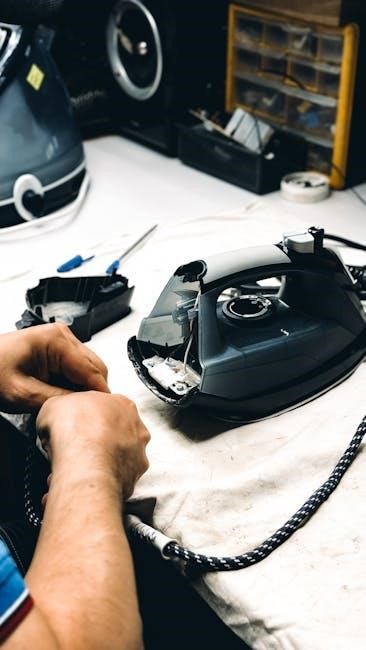Cable guide rollers are essential mechanical components designed to manage and direct cables safely and efficiently in various applications. They ensure proper cable routing, preventing damage and tangling while maintaining organization.
1.1 Definition and Purpose
Cable guide rollers are mechanical components designed to manage and direct cables, wires, or hoses in various industrial and technical applications. Their primary purpose is to ensure smooth cable movement, prevent tangling, and reduce wear and tear. These rollers are typically mounted on surfaces or integrated into systems to guide cables safely and efficiently. By minimizing friction and maintaining proper alignment, cable guide rollers play a crucial role in maintaining system performance and reliability. They are essential for applications requiring precise cable control, such as machinery, robotics, and medical equipment, ensuring optimal functionality and longevity.
1.2 Importance in Cable Management
Cable guide rollers are indispensable in cable management systems, ensuring cables are protected from damage, tangling, and wear. They play a critical role in maintaining the integrity and functionality of cables in industrial, robotic, and medical applications. By providing a smooth, guided path, these rollers prevent abrasion and stress on cables, which could lead to premature failure. Their use enhances safety by keeping workspaces organized and reducing tripping hazards. Additionally, they contribute to system efficiency and reliability, ensuring cables move freely and remain secure in dynamic environments. This makes them a vital component in modern cable management solutions, optimizing performance and durability across various industries.

Types of Cable Guide Rollers
Cable guide rollers come in various types, including fixed, movable, and customizable options, each designed to suit specific applications for efficient and reliable cable management across industries.

2.1 Fixed Cable Guide Rollers
Fixed cable guide rollers are designed for permanent installation, providing a stable and consistent path for cables. They are typically mounted on surfaces or equipment, ensuring cables remain secure and untangled. These rollers are ideal for applications requiring minimal movement, such as in industrial machinery or fixed installations. Their durability and simplicity make them a reliable choice for long-term cable management solutions. Fixed rollers are often made from robust materials to withstand heavy-duty use, ensuring longevity and performance in demanding environments.

2.2 Movable Cable Guide Rollers
Movable cable guide rollers offer flexibility and adaptability in cable management. Designed to allow easy repositioning, these rollers are ideal for applications requiring frequent adjustments or temporary setups. They are commonly used in robotics, automation, and portable equipment where cable routing may change. Their smooth-rolling surfaces reduce friction, minimizing wear on cables. Movable rollers often feature adjustable mounts or wheels, enabling quick installation and reconfiguration. This versatility makes them a practical solution for dynamic environments where cable management needs evolve over time. Their ease of use enhances operational efficiency in various industries.
2.3 Customizable Cable Guide Rollers
Customizable cable guide rollers are tailored to meet specific application needs, offering flexibility in design and functionality. These rollers can be modified in terms of material, size, and shape to suit unique requirements. They often feature adjustable or interchangeable components, such as replaceable sleeves or grooved surfaces, to accommodate various cable sizes and types. This customization ensures optimal performance in diverse environments, from industrial machinery to robotics. Their adaptability makes them ideal for applications where standard rollers may not suffice, providing enhanced durability and efficiency in cable management systems;

Materials Used for Cable Guide Rollers
Cable guide rollers are typically made from durable materials such as plastics, metals, and composites, chosen for their strength, weight, and resistance to wear and tear.
3.1 Plastic Cable Guide Rollers
Plastic cable guide rollers are lightweight, corrosion-resistant, and cost-effective solutions for cable management. Made from materials like nylon or polycarbonate, they offer smooth cable movement and durability. Often used in applications where weight reduction is critical, plastic rollers are ideal for light-duty systems. They are also resistant to environmental factors such as moisture and chemicals, making them suitable for various industries. Despite their lighter construction, plastic cable guide rollers provide reliable performance, ensuring cables remain organized and protected from abrasion. Their versatility and affordability make them a popular choice in many modern setups.
3.2 Metal Cable Guide Rollers
Metal cable guide rollers are durable and robust, designed for heavy-duty applications where strength and longevity are essential. Constructed from materials like steel or aluminum, they provide superior resistance to wear and tear. These rollers are ideal for industrial settings, offering high load capacities and minimal deflection under stress. Metal rollers are also highly customizable, allowing for precise engineering to meet specific requirements. Their sturdy construction ensures reliable performance in harsh environments, making them a preferred choice for demanding cable management systems. This durability ensures sustained efficiency and reduced maintenance over time.
3.3 Composite Material Cable Guide Rollers
Composite material cable guide rollers combine high strength with lightweight properties, making them ideal for applications requiring both durability and reduced weight. These rollers are typically made from a mix of materials, such as plastics and fibers, offering excellent resistance to corrosion and chemicals. They are often used in environments where metal rollers might be too heavy or prone to degradation. Composite rollers also provide a smooth surface for cable movement, minimizing friction and wear. Their versatility and customizable designs make them suitable for robotics, medical equipment, and other specialized systems, ensuring reliable performance in diverse settings.

Applications of Cable Guide Rollers
Cable guide rollers are widely used in industrial machinery, robotics, medical equipment, and consumer electronics, ensuring efficient cable management and organization across various industries.
4.1 Industrial Machinery
In industrial machinery, cable guide rollers play a crucial role in managing cables used for power transmission, data communication, and control systems. They ensure cables move smoothly without tangling or damage, enhancing operational efficiency. These rollers are often integrated into automated systems, conveyor belts, and heavy-duty equipment. By maintaining proper cable alignment and minimizing wear, they contribute to the overall durability and performance of industrial machinery. This makes them indispensable in manufacturing and production environments where reliable cable management is essential for continuous operations.
4.2 Robotics and Automation
In robotics and automation, cable guide rollers are vital for managing cables that power and control robotic arms, sensors, and automated systems. These rollers ensure cables move smoothly and consistently, reducing wear and tear. They are designed to handle dynamic movements, such as rotational and linear motions, common in robotic applications. By preventing cable tangling and damage, they enhance system reliability and uptime. This makes cable guide rollers essential components in modern automation, supporting precise and efficient operations across various industries, from manufacturing to healthcare.
4.3 Medical Equipment
In medical equipment, cable guide rollers play a crucial role in managing cables for devices like patient monitors, imaging machines, and surgical robots. These rollers ensure cables remain organized and untangled, minimizing the risk of equipment failure or patient tripping hazards. Their smooth operation allows for precise control and movement in critical care environments. Durability and resistance to sterilization processes are key, ensuring longevity in demanding healthcare settings. This contributes to maintaining the reliability and safety of medical equipment, which is essential for patient care and operational efficiency in hospitals and clinics.
4.4 Consumer Electronics
Cable guide rollers are integral to consumer electronics, ensuring seamless cable management in devices like TVs, gaming consoles, and smart home systems. They prevent cable tangling and damage, enhancing durability and user experience. By organizing cables neatly, these rollers reduce clutter and improve device aesthetics. Their smooth operation allows for easy cable routing, while durable materials ensure longevity. This contributes to reliable performance and longevity of electronic devices, making them an essential component in modern consumer electronics design and functionality.

Installation and Setup
Proper installation of cable guide rollers ensures smooth cable movement and longevity. They are typically mounted on surfaces or integrated into machinery, securely fastening cables in place.
5.1 Mounting Techniques
Mounting cable guide rollers requires precise techniques to ensure durability and functionality. Common methods include clamp-on, bolt-on, or adhesive mounting, depending on the surface and application. Clamp-on rollers are ideal for temporary installations, while bolt-on systems provide permanent solutions. Adhesive-mounted rollers are suitable for lightweight applications. Proper alignment and secure fastening are critical to prevent cable damage. Surface preparation, such as cleaning or applying primer, enhances adhesion. Always consult the manufacturer’s guidelines for specific mounting recommendations to ensure safety and optimal performance. Regular inspections and adjustments are recommended to maintain efficiency;
5.2 Adjusting Tension and Alignment
Proper tension and alignment are crucial for optimal cable guide roller performance. Adjustments ensure smooth cable movement, preventing wear and tear. Tension should be set to avoid slack or excessive tightness, which can damage cables or rollers. Alignment involves positioning rollers to guide cables straight or around curves without misdirection. Use adjustment screws or bolts to fine-tune alignment, ensuring even cable distribution. Regular checks and tweaks are essential, especially in dynamic environments. Misaligned or overly tense systems can lead to cable failure or equipment downtime, making precise adjustments vital for reliability and efficiency.

Maintenance and Repair
Regular maintenance ensures cable guide rollers function effectively, preventing wear and tear. Cleaning and lubricating rollers maintain smooth operation and extend lifespan. Replace damaged parts promptly.
6.1 Cleaning Cable Guide Rollers
Cleaning cable guide rollers is essential for maintaining their efficiency and longevity. Regularly remove dirt, dust, and debris using a soft brush or compressed air. For tougher residue, a mild detergent solution can be applied, but ensure no harsh chemicals are used. Always power down equipment before cleaning to prevent damage. Proper cleaning prevents cable abrasion and ensures smooth operation. Consistent maintenance reduces wear and tear, extending the lifespan of both rollers and cables. This simple process is crucial for optimal performance in any application.
6.2 Replacing Damaged Rollers
Replacing damaged cable guide rollers is crucial to prevent further cable wear and system malfunction. Inspect rollers regularly for signs of wear, such as cracks or excessive friction. When replacing, ensure the new roller matches the specifications of the original to maintain compatibility. Power down all connected systems and follow manufacturer guidelines for removal and installation. Proper alignment and secure mounting are key to ensure smooth cable movement. Regular replacement of damaged rollers enhances reliability and safety, minimizing downtime and extending system lifespan. This proactive approach guarantees optimal performance.

Safety Considerations
Proper installation and maintenance of cable guide rollers ensure worker safety and prevent accidents. Regular inspections and timely replacements are essential to avoid cable-related hazards.
7.1 Preventing Cable Damage
Cable guide rollers play a crucial role in preventing cable damage by ensuring proper routing and minimizing stress on the cables. Correct installation and alignment are essential to avoid friction and abrasion, which can lead to premature wear. Using rollers made from durable materials, such as metal or high-quality plastics, ensures longevity and resistance to environmental factors. Regular inspections and maintenance help identify potential issues before they cause damage. Additionally, tension adjustment features on some rollers prevent over-stretching or pinching, further safeguarding the cables during operation.
7.2 Ensuring Worker Safety
Worker safety is a top priority when using cable guide rollers, as improper installation or maintenance can lead to accidents. Ensuring that all rollers are securely fastened and cables are properly secured reduces the risk of tripping hazards or unexpected cable movement. Additionally, regular inspection of rollers for wear and tear helps prevent sudden failures that could endanger nearby personnel. Training employees on proper handling and maintenance procedures further enhances safety, creating a more secure working environment for everyone involved in cable management systems.
Cable guide rollers play a crucial role in efficient cable management across various industries, ensuring safety, durability, and organization. Their versatility in design, material, and application makes them indispensable in modern machinery, robotics, and electronics. By understanding their types, proper installation, and maintenance, users can maximize their benefits while minimizing risks. As technology advances, the demand for reliable cable guide rollers will continue to grow, making them a fundamental component in both current and future applications. Their importance lies in their ability to streamline operations and protect critical cable systems.